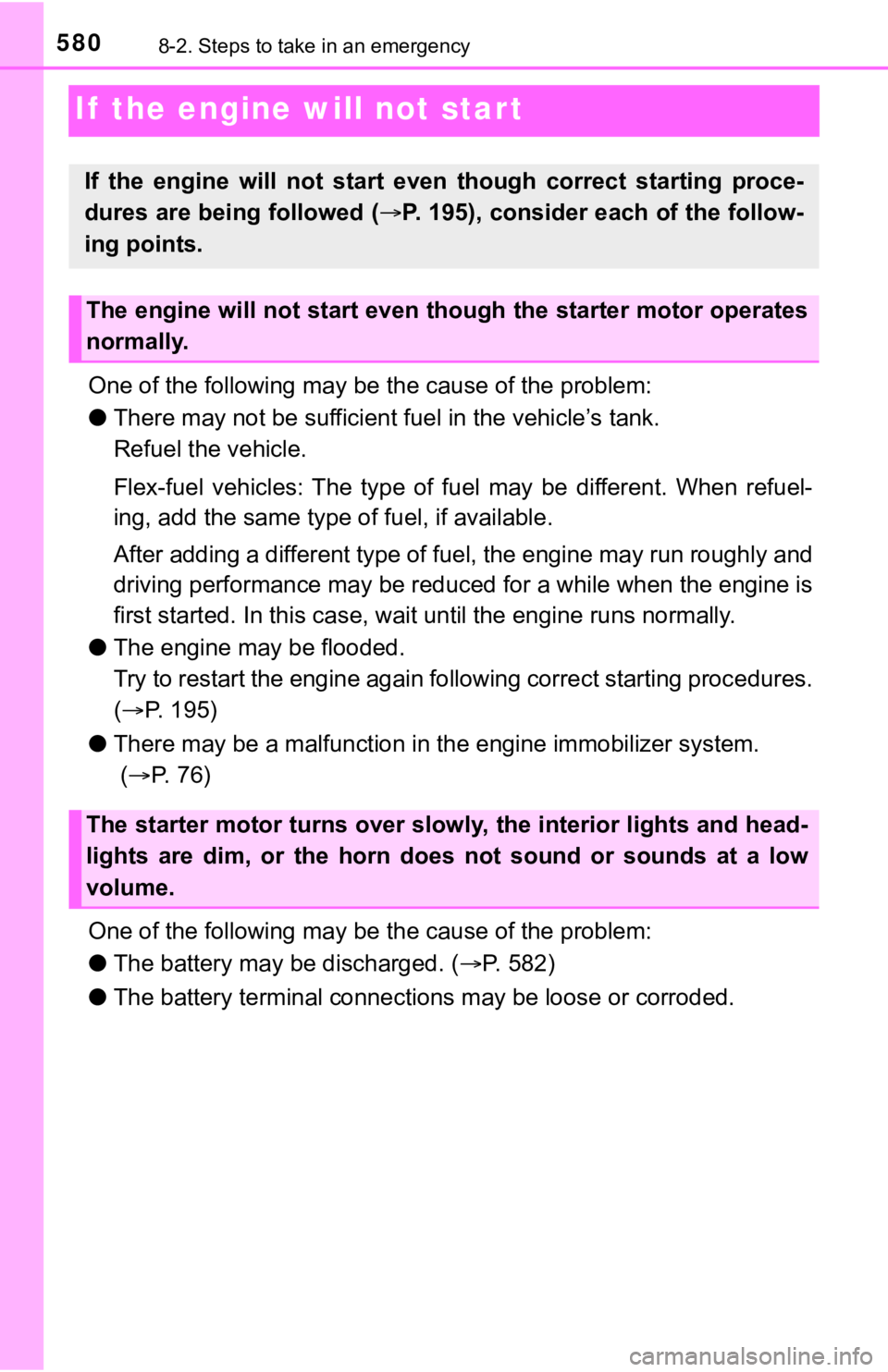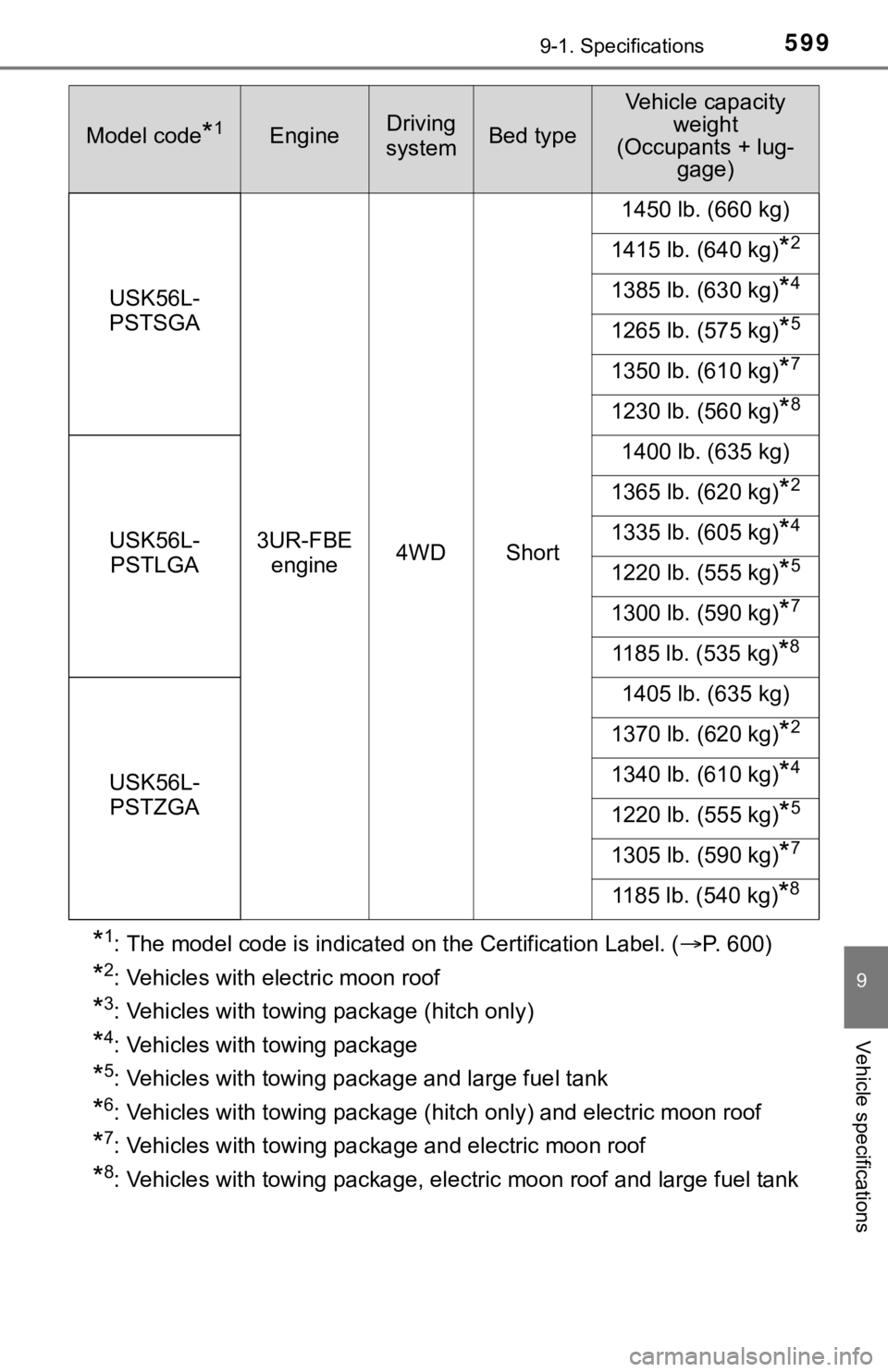Page 551 of 672

5518-2. Steps to take in an emergency
8
When trouble arises
Front passenger’s seat belt buzzer:
The front passenger’s seat belt buzzer sounds to alert the front passenger
that his or her seat belt is not fastened. The buzzer sounds on ce if the
vehicle reaches a speed of 12 mph (20 km/h). If the seat belt is sill unfas-
tened after 30 seconds, the buzzer will sound intermittently fo r 10 seconds.
Then, if the seat belt is still unfastened, the buzzer will sou nd in a different
tone for 20 more seconds.
*2: Parking brake engaged warning buzzer:
A buzzer will sound if the vehicle is driven at a speed of approximately
3 mph (5 km/h) or more.
■ SRS warning light
This warning light system monitors the airbag sensor assembly, front impact
sensors, side impact sensors (front door), side impact sensors (rear), driver’s
seat position sensor, driver’s seat belt buckle switch, front passenger occu-
pant classification system (ECU and sensors), “AIR BAG ON” indi cator light,
“AIR BAG OFF” indicator light, front passenger’s seat belt buck le switch, seat
belt pretensioners assemblies, airbags, interconnecting wiring and power
sources. ( P. 40)
■ Front passenger detection sensor, seat belt reminder and warnin g
buzzer
● If luggage is placed on the front passenger seat, the front pas senger detec-
tion sensor may cause the warning light to flash and the warnin g buzzer to
sound even if a passenger is not sitting in the seat.
● If a cushion is placed on the seat, the sensor may not detect a passenger,
and the warning light may not operate properly.
■ If the malfunction indicator lamp comes on while driving
First check the following:
●Is the fuel tank empty?
If it is, fill the fuel tank immediately.
● Is the fuel tank cap loose?
If it is, tighten it securely.
The light will go off after several driving trips.
If the light does not go off even after several trips, contact your Toyota dealer
as soon as possible.
Page 553 of 672

5538-2. Steps to take in an emergency
8
When trouble arises
WARNING
■If both the ABS and the brake s ystem warning lights remain on
Stop your vehicle in a safe place immediately and contact your To y o t a
dealer. The vehicle will become extremely unstable during braki ng, and the
ABS system may fail, which could cause an accident resulting in death or
serious injury.
■ If the tire pressure warning light comes on
Be sure to observe the following precautions. Failure to do so could cause a
loss of vehicle control and result in death or serious injury.
● Stop your vehicle in a safe place as soon as possible. Adjust the tire infla-
tion pressure immediately.
● If the tire pressure warning light comes on even after tire inf lation pressure
adjustment, it is probable that you have a flat tire. Check the tires. If a tire
is flat, change it with the spare tire and have the flat tire repaired by the
nearest Toyota dealer.
● Avoid abrupt maneuvering and braking. If the vehicle tires deteriorate, you
could lose control of the steering wheel or the brakes.
■ If a blowout or sudden air leakage should occur
The tire pressure warning system may not activate immediately.
■
Maintenance of the tires
Each tire, including the spare (if provided), should be checked monthly
when cold and inflated to the inflation pressure recommended by the
vehicle manufacturer on the vehicle placard or tire inflation p ressure
label (tire and load information label). (If your vehicle has t ires of a dif-
ferent size than the size indica ted on the vehicle placard or tire inflation
pressure label [tire and load information label], you should de termine
the proper tire inflation p ressure for those tires.)
As an added safety feature, your vehicle has been equipped with a tire
pressure monitoring system (TPMS -tire pressure warning system) that
illuminates a low tire pressure telltale (tire pressure warning light) when
one or more of your tires is significantly under-inflated. Acco rdingly,
when the low tire pressure telltale (tire pressure warning ligh t) illumi-
nates, you should stop and check your tires as soon as possible , and
inflate them to the proper pressure. Driving on a significantly under-
inflated tire causes the tire to overheat and can lead to tire failure.
Under-inflation also reduces fuel efficiency and tire tread lif e, and may
affect the vehicle’s handl ing and stopping ability.
Page 558 of 672

5588-2. Steps to take in an emergency
Indicates that the washer fluid level is low
Add washer fluid.
(If equipped)
Indicates that intuitive parking assist is dirty or
covered with ice
Clean the sensor.
(If equipped)
Indicates that the Blind Spot Monitor sensors or
the surrounding area on the bumper is dirty or
covered with ice
A buzzer also sounds.
Clean the sensor and its surrounding area
on the bumper.
Standard fuel tank
Indicates remaining fuel is approximately 4.0 gal.
(15.0 L, 3.3 Imp.gal.) or less
Large fuel tank
Indicates remaining fuel is approximately 3.8 gal.
(14.4 L, 3.2 lmp.gal.) or less
A buzzer also sounds.
Refuel the vehicle.
(U.S.A.)
Indicates that all maintenance according to the
driven distance on the maintenance schedule
*
should be performed soon.
Comes on approximately 4500 miles (7200 km)
after the message has been reset.
If necessary, perfo rm maintenance.
Warning messageDetails/Actions
Windshield
Washer Fluid Low
Clean Parking Assist Sensor
Blind Spot
Monitor
Unavailable
Fuel Low
Maintenance
Required Soon
Page 580 of 672

5808-2. Steps to take in an emergency
If the engine will not star t
One of the following may be the cause of the problem:
● There may not be sufficient f uel in the vehicle’s tank.
Refuel the vehicle.
Flex-fuel vehicles: The type of fuel may be different. When ref uel-
ing, add the same type of fuel, if available.
After adding a different type of fuel, the engine may run roughly and
driving performance may be reduced for a while when the engine is
first started. In this case, wa it until the engine runs normall y.
● The engine may be flooded.
Try to restart the engine again following correct starting proc edures.
( P. 195)
● There may be a malf unction in the engine immobilizer system.
( P. 7 6 )
One of the following may be the cause of the problem:
● The battery may be discharged. ( P. 582)
● The battery terminal connecti ons may be loose or corroded.
If the engine will not start eve n though correct starting proce -
dures are being followed ( P. 195), consider each of the follow-
ing points.
The engine will not start even t hough the starter motor operates
normally.
The starter motor turns over slowly, the interior lights and he ad-
lights are dim, or the horn does not sound or sounds at a low
volume.
Page 591 of 672
591
9Vehicle specifications
9-1. SpecificationsMaintenance data (fuel, oil level, etc.) .......... 592
Fuel information ................ 610
Tire information ................. 614
9-2. Customization Customizable features ...... 624
9-3. Items to initialize Items to initialize ............... 632
Page 592 of 672
5929-1. Specifications
Maintenance data (fuel, oil level, etc.)
2WD models
*1: Unladen vehicle
*2: P255/70R18 tires
*3: P275/65R18 tires
*4: P275/55R20 tires
Dimensions
Cab typeDouble Cab CrewMax
Bed typeStandardLongShort
Overall length228.9 in. (5815
mm) 247.8 in.
(6295 mm) 228.9 in.
(5815 mm)
Overall width 79.9 in. (2030 mm)
Overall
height
*1
75.9 in.
(1930 mm)
*275.7 in.
(1925 mm)
*2
75.7 in.
(1925 mm)
*3,*475.5 in.
(1920 mm)
*3,*4
Wheelbase 145.6 in. (3700
mm) 164.5 in.
(4180 mm) 145.6 in.
(3700 mm)
Front tread 67.9 in. (1725 mm)
Rear tread67.9 in. (1725 mm)
Page 595 of 672
5959-1. Specifications
9
Vehicle specifications
*1: The model code is indicated on the Certification Label. (P. 6 0 0 )
*2: Vehicles with towing package (hitch only)
*3: Vehicles with towing package
*4: Vehicles with towing package and large fuel tank
Model code*1EngineDriving
systemBed type
Vehicle capacity weight
(Occupants + lug- gage)
USK56L- CRTSKA
3UR-FE engine
4WDStandard
1500 lb. (680 kg)
1435 lb. (650 kg)*3
1320 lb. (600 kg)*4
USK56L-
CRTLKA
1485 lb. (675 kg)
1420 lb. (645 kg)*3
1300 lb. (590 kg)*4
USK57L-
CHTSKA Long
1475 lb. (670 kg)
1410 lb. (640 kg)*3
1290 lb. (585 kg)*4
USK56L-
CRTSGA
3UR-FBE engine Standard
1500 lb. (680 kg)
1435 lb. (650 kg)*3
1320 lb. (600 kg)*4
USK56L-
CRTLGA
1485 lb. (675 kg)
1420 lb. (645 kg)*3
1300 lb. (590 kg)*4
USK57L-
CHTSGA Long
1475 lb. (670 kg)
1410 lb. (640 kg)*3
1290 lb. (585 kg)*4
Page 599 of 672

5999-1. Specifications
9
Vehicle specifications
*1: The model code is indicated on the Certification Label. (P. 6 0 0 )
*2: Vehicles with electric moon roof
*3: Vehicles with towing package (hitch only)
*4: Vehicles with towing package
*5: Vehicles with towing package and large fuel tank
*6: Vehicles with towing package (hi tch only) and electric moon roof
*7: Vehicles with towing package and electric moon roof
*8: Vehicles with towing package, el ectric moon roof and large fuel tank
USK56L-
PSTSGA
3UR-FBE engine 4WD Short 1450 lb. (660 kg)
1415 lb. (640 kg)
*2
1385 lb. (630 kg)*4
1265 lb. (575 kg)*5
1350 lb. (610 kg)*7
1230 lb. (560 kg)*8
USK56L- PSTLGA 1400 lb. (635 kg)
1365 lb. (620 kg)
*2
1335 lb. (605 kg)*4
1220 lb. (555 kg)*5
1300 lb. (590 kg)*7
1185 lb. (535 kg)*8
USK56L- PSTZGA 1405 lb. (635 kg)
1370 lb. (620 kg)
*2
1340 lb. (610 kg)*4
1220 lb. (555 kg)*5
1305 lb. (590 kg)*7
1185 lb. (540 kg)*8
Model code*1EngineDriving
systemBed type
Vehicle capacity weight
(Occupants + lug-
gage)